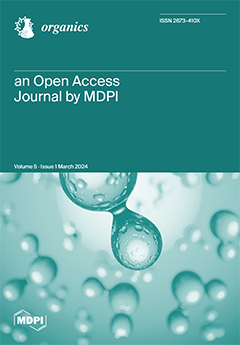The chloro-
P,
N-{diphenylphosphanyl-[(5-phenyl-1,3,4-oxadiazol-2-ylamino)phenyl-me- thyl]}(
p-cymene)ruthenium(II) hexafluorophosphate complex (
4) was obtained in two steps from diphenylphosphanyl-[(5-phenyl-1,3,4-oxadiazol-2-ylamino)phenyl-methyl] borane (
2). In the first step, the oxadiazole ring coordinated with the ruthenium atom, resulting in the formation of the
[...] Read more.
The chloro-
P,
N-{diphenylphosphanyl-[(5-phenyl-1,3,4-oxadiazol-2-ylamino)phenyl-me- thyl]}(
p-cymene)ruthenium(II) hexafluorophosphate complex (
4) was obtained in two steps from diphenylphosphanyl-[(5-phenyl-1,3,4-oxadiazol-2-ylamino)phenyl-methyl] borane (
2). In the first step, the oxadiazole ring coordinated with the ruthenium atom, resulting in the formation of the dichloro-
N-{diphenylphosphanyl-[(5-phenyl-1,3,4-oxadiazol-2-ylamino)phenyl-methyl]borane}(
p-cymene) ruthenium(II) complex (
3). During the crystallization of the
P,
N-chelate ruthenium complex, the formation of conglomerate crystals was revealed by X-ray structure analysis. Only two stereoisomers were obtained with (
S)-Ru and (
R)-C configurations in the first complex and with (
R)-Ru and (
S)-C configurations in the second. This deracemization during crystallization is due to the formation of a hydrogen bond between the
P,
N-ligand and the chlorine atom (CH•••Cl). This supramolecular interaction allows the transfer of the ligand chirality to the metal center and decrees the stereochemistry of the ruthenium atom.
Full article





